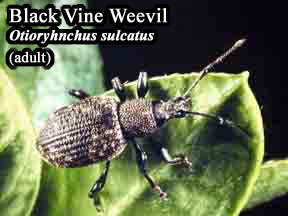Firethorn (Pyracantha)
Plant Health Problems
See Apple for a detailed discussion of problems that may also occur on firethorn.
Diseases caused by Fungi:
Scab, Spilocaea pyracanthae.
Scab causes circular, olive-black, velvety spots on the leaves and dark spots on the red berries.
Disease control is aided by raking and removing fallen leaves and by pruning dead twigs and branches. Resistant cultivars are available; among these are Pyracantha "Firey Cascade", P. crenato-sessata, "Yunan Firethorn", "Shawnee", "Rutgers", and "Santa Cruz Prostata." Chemical control is usually not necessary except for new transplants or for plants that have been repeatedly defoliated for several years. Control can also be achieved with the use of fungicide sprays. Among the compounds registered for use in Connecticut are chlorothalonil, chlorothalonil plus fenarimol, thiophanate-methyl, and mancozeb. Consult the label for dosage rates and safety precautions.
Diseases caused by Bacteria:
Fire blight, Erwinia amylovora.
Symptoms are similar to those found on apple. Flowers wither and blacken, young twigs and branches die from the terminals back and appear as though they were burned. See Apple for a more detailed discussion of this disease.
Management of this disease relies mainly on pruning and removing the infected branches, making sure to cut at least 12 inches below visible symptoms when the bark is dry. Care should be taken to disinfest all tools between cuts. Cultivars Mojave and Shawnee have been reported to be resistant.
For more information, see the fact sheet on Fire Blight.
Insect Problems
Apple aphid, Aphis pomi.
Aphids damage leaves on water sprouts and rapidly growing terminal shoots. In the fall, females lay elongate shiny, black eggs on the bark. The nymphs hatch from eggs in the spring. Both the nymphs and adults of this small green aphid leaves and soft stems to suck the sap. During the growing season, apple aphids have many generations, during which young are produced asexually. In the fall, sexual forms appear, and after mating, the females lay the eggs that will overwinter. Heavy fertilization with nitrates may increase aphid infestations. Materials registered in Connecticut to control aphids include horticultural oil, azadirachtin, and insecticidal soap. Dormant sprays of horticultural oil have been marginally effective because of later migration. Sprays of azadirachtin or soap can control aphids. Imidacloprid applied as a drench to the roots provides long-lasting systemic control. If using insecticides, follow the label instructions. Natural enemies, such as syrphid flies, ladybird beetles, and lacewings, sometimes adequately control apple aphids.
 Black vine weevil, Otiorhynchus sulcatus.
Black vine weevil, Otiorhynchus sulcatus.
The larvae of this weevil often injure Pyracantha in nurseries and ornamental plantings by feeding on the roots. The small grubs devour the small roots and progress to chewing the bark from the larger roots, often girdling them. The tops of girdled plants first turn yellow, then brown, and the severely injured plants die. Large landscape plants tolerate root grazing quite well, but leaf notching by adults can be unsightly. The 1/2" long adult weevil is black, with a beaded appearance to the thorax and scattered spots of yellow hairs on the wing covers. Only females are known, and the adults are flightless. They feed nocturnally, notching the margins of the foliage. The legless grub is white with a brown head and is curved like grubs of other weevils. Adults and large larvae overwinter, emerging from May - July. The adults have to feed for 3-4 weeks before being able to lay eggs. Treating the soil with insect pathogenic nematodes may control the larvae and should be the first line of defense for landscape plantings. Acephate and fluvalinate are among the compounds registered for control of this pest in Connecticut, and may be applied when there is adult feeding and before egg laying starts. The usual timing for these foliar sprays is during May, June and July at three week intervals. Insecticide resistance is very common; be aware that adults may appear to be dead following contact with fluvalinate, but may recover from poisoning within a few days. Consult the labels for dosage rates and safety precautions.
Calico scale, Eulecanium cerasorum.
Calico scales produce copious honeydew, which supports the growth of sooty mold. This soft scale overwinters as partially grown nymphs. Fully grown scales are hemispherical, with a dark background and white spots. The one annual generation of crawlers hatch from eggs in June. Imidacloprid, registered in Connecticut, provides at least one season of control when applied as a systemic in the spring to be taken up by the roots.

